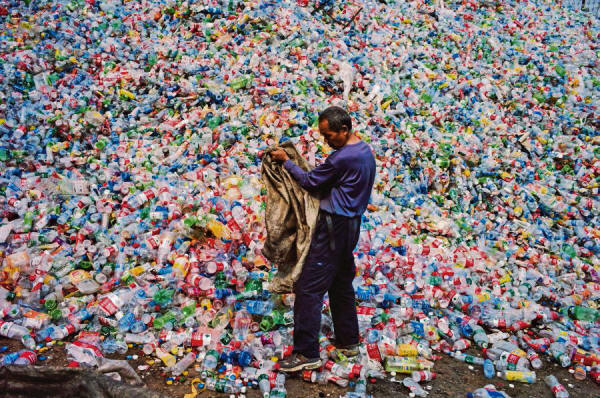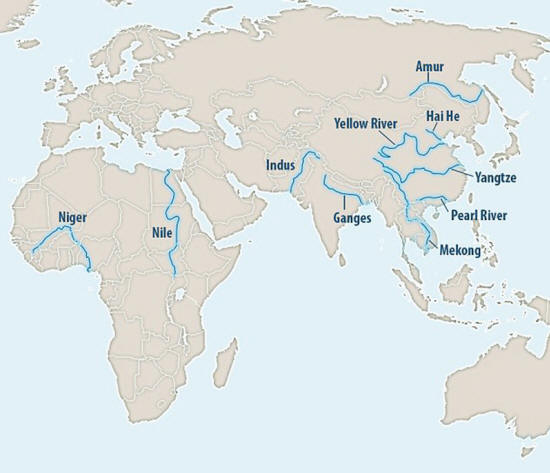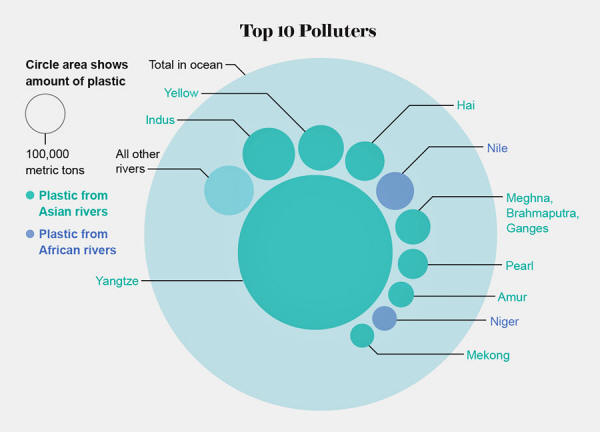|

by Frank Jacobs
August 10,
2018
from
BigThink Website

Source
Cheap, durable and multifunctional, plastic is one of humanity's
most successful inventions.
From the 1950s to 2015,
we've produced 8.3 billion metric tons of the stuff.
By now, it's everywhere. It's also non-biodegradable. And that's
devastating the environment.
Only 9% of all plastic
waste has been recycled, and another 12% has been incinerated.
That means that almost
80% - nearly 6.3 billion tons - has turned into waste with no
half-life to speak of:
condemned to an
eternity as landfill, litter or ocean-clogging junk.
Every year, plastic kills
around,
The volume of plastic
trash in the world's oceans is currently estimated to be around
150 million tons.
No less than eight
million tons are added to that every year - that's one truckload
every minute. Between 0.5 and 2.75 million tons come from rivers
alone.
Large rivers are particularly efficient conveyors of plastic waste
to the oceans, especially in countries lacking a well-developed
waste management infrastructure. Up to 95% of river-borne plastic
comes from just 10 rivers, scientists at the Helmholtz Center for
Environmental Research in Leipzig, Germany have found.
The scientists analyzed data on both
microplastic debris (<5mm) such
as beads and fibres, as well as microplastic objects (plastic
bottles, bags, etc.) from 79 sampling sites on 57 of the world's
largest rivers, singling out the 10 mapped out here as the biggest
culprits, due to,
"mismanagement of
plastic waste in their watersheds".

The
Yangtze alone
discharges as much as 1.5 million tons
of
plastic waste each year
Source
As this map shows, eight of the rivers are in Asia.
Four are solely in China:
-
The Yangtze,
which flows into the East China Sea
-
The Hai He and
the Yellow River, both debouching in the Yellow Sea
-
The Pearl River,
going into the South China Sea
Two others closely
involve China:
-
The Amur rises in
Russia and flows into the Sea of Okhotsk, but for a large
part of its course forms the border with China (where it's
called Heilong Jang).
-
The Mekong rises
in China, but touches or crosses Myanmar, Laos, Thailand,
Cambodia and Vietnam on its way to the South China Sea.
Two flow through the
Indian subcontinent:
-
The Indus, which
rises in China and crosses India, but mainly runs through
Pakistan, ending in the Arabian Sea.
-
The Ganges,
flowing through India and Bangladesh, into the Bay of
Bengal.
The two non-Asian rivers
are both in Africa:
-
The Nile, with
two sources in Ethiopia (Blue Nile) and Rwanda (White Nile)
and flowing through Uganda, South Sudan, Sudan and Egypt
towards the Mediterranean.
-
The Niger, rising
in Guinea and flowing through Mali, Niger, Benin and Nigeria
into the Gulf of Guinea.
Not all of these rivers
are equally guilty.
As the graph below shows,
the Yangtze is the main
culprit, ejecting around 1.5 million tons of plastic into
the East China Sea. That's more than the other nine rivers combined.

Source
While awareness of the
issue is rising, plastic pollution itself is still on the increase
as well.
-
In 2016, 480
billion plastic bottles were sold globally.
-
By 2021, that
figure will be close to 540 billion.
Fewer than half of that
total is currently recycled.
If current trends continue, the amount of plastic dumped into the
ocean will increase to one truckload every minute today to one every
15 seconds in 2050, by which time plastic waste will literally
outweigh all the fish in the ocean.
However, as the scientists from Leipzig point out, quick fixes are
possible.
Focusing waste management
efforts on just these 10 rivers could put a serious dent in the
plastic pollution trend.
Halving the discharge of
plastic waste in Yangtze, Ganges, Niger and the other seven rivers
listed above would reduce the global flow of river-borne plastic
into the oceans by no less than 45%.
|




